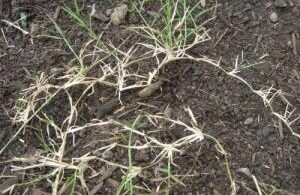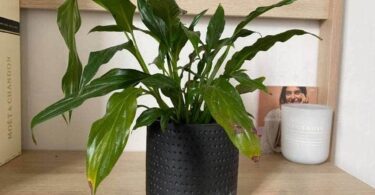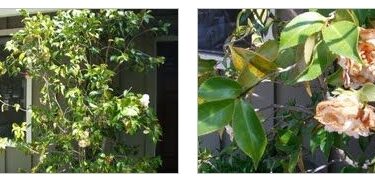We have cocoa intercropped in a rubber plantation. It’s flowering and fruit setting time now. As seen in the picture below, the majority of the fruits that have set, turn black and dry off at this small stage itself. It is caused by a pathogen in the genus Phytophthora. Locally, a Bordeaux mixture or Carbendazim fungicide is sprayed every 30 days to combat this. Location: Kerala, South IndiaClimate: Tropical Monsoon. It is summer now. We have started receiving summer rain in the evening. Daytime it’s very hot and humid. First week of June, the monsoon starts.

Thank you
Jose Mathew
Dr. Radko Tichavsky:
Dear Jose,
I first recommend reducing Carbendazim and Bordeaux mixture to 30% for the first month and three weeks after the last application, use a live bionosode of Trichoderma harzianum at the 2 JT potency (in non-chlorinated water).
You will need to purchase a small amount of Trichoderma harzianum and replicate it on potato dextrose agar (PDA) until you see small white or greenish dots developing, then you will see the conidia of T. harzianum, which are an emerald green color.
It is important to maintain sterile conditions, wash utensils and containers very well, and after mixing the PDA and inoculating with T. harzianum, cover with plastic wrap and secure with a rubber band to prevent proliferation of other competing fungi.
Replication can take between 5-7 days (with a temperature between 25-30 degrees Celsius). Once you have obtained the amount of fresh mycelium, you can make the dilution in non-chlorinated water and dynamize it.
It is applied by spraying onto cocoa trees early in the morning to avoid the sun. The
application should be repeated at least twice a month for the first two months. If you want to boost the antifungal action of T. harzianum, look for a nursery that has Hedera helix, you will need one small plant. Wash its roots and the water from its roots contains the bacteria Bacillus amyloliquefaciens.
Prepare a live bionosode in non-chlorinated water at the 3 JT potency and mix it with the bionosode of Trichoderma harzianum. Both Trichoderma harzianum and Bacillus amyloliquefaciens once established in your orchard will continue to grow (as long as you stop applying bordeaux mixture and Carbendazim).
Bordeaux mixture and Carbendazim are only palliative and in the long run make Phytophthora sp. increasingly resistant, once you see results from the homeopathic application, you can discontinue the previous treatments. To eliminate residues of Carbendazim in your soil, prepare a mother tincture in alcohol of Trametes versicolor, (this mushroom contains laccase, manganese peroxidase and lignin peroxidase enzymes), then dynamize it to the 4 JT potency and apply several times to the soil, always alternating with applications of T. harzianum and B. amyloliquefascies.
This will heal your orchard by draining residues of methyl benzimidazol-2-ylcarbamate (Carbendazim) whose use is regulated in many countries and, in some cases, restricted due to environmental and health concerns.
Dear Dr. Tichavsky,
Our front Garden Box Hedge is dying. It’s being eaten by caterpillars which leave cotton wool-like kind of covering on the leaves as they eat the bush. The caterpillars eat the new leaves, the busk looks dry, grey, as if it’s dying. We live in Northern Europe, in the SE of the UK, in a small village We had a dry winter with little rain.

Thank you
Grace
Radko Tichavsky:
Dear Grace,
The image shows the larva of Cydalina perspectalis that is a pest of Buxus sepervivens. Prepare a combined mother tincture of Allium sativum, Artemisia absinthium, Azadirachta indica and leaves of Lycopersicum esculentum. Dynamize it to the 4 JT potency and spray it on the infected plants.
Another possibility is to apply a live bionosode (in non-chlorinated water) of Bacillus thuringiensis, which can be acquired online. To restore the vitality of your plants, you can apply a mixture of gibberellic acid 3, indole-3-acetic acid and salicylic acid.
Germinate some peas, lentils and corn, and once the seeds generate the cotyledon, separate the cotyledons and make a blended liquid of them in non-chlorinated water, then filter, and use the liquid part to make a live bionosode at the 3 JT potency.
On the other hand, prepare a decoction of Pequeñas ramitas small twigs of Salix babylonica in water, let cool to room temperature, dynamize to the 3 JT potency and mix with the first bionosode. Apply as a spray to the above-ground parts of the Buxus and also to the soil.
Dear Dr. Tichavsky,
I am writing to seek your expertise regarding a pest infestation affecting my Jasmine flowers and Lilly (Tuberose). I have identified the presence of blossom midge pests, and I am concerned about the health and vitality of my plants. Along with this, Lilly plants are suffering with Mealybugs. I live in Andhra Pradesh, South India. In my area the wet season is hot and overcast and the dry season is sweltering, muggy, and mostly clear. Over the course of the year, the temperature typically varies from 65°F to 105°F and is rarely below 60°F or above 112°F. Please suggest remedy. Thank you so much.


Best Regards,
Pavan Kumar
Radko Tichavksy:
Dear Pavan,
The small flies associated with Polianthes tuberosa flowers are probably Liriomyza trifoli. They reproduce quickly, as a single fly can lay up to 300 eggs in its lifetime (3 weeks), and the small flies can transmit the fungus Botrytis cinerea. Establish contiguous crops of Calendula officinale, which will serve as an alternative host and divert the pest from the Polianthes tuberosa crop.
Mites, spiders, and lacewings prey on their eggs and larvae. For example, in your region, the predatory mites Amblyseius cucumeris, Amblydromalus limonicus, Typhlodromips swirskii, Iphiseius degenerans, Neoseiulus barkeri, spiders Oecobius spp. and Clubiona spp., and lacewings Chrysoperla carnea, Mallada basalis, Ceraeochrysa spp., and also the parasitic wasp Tamarixia triozae are present.
As for the cottony cushion scale (probably Dactylopius romentosus), they do not kill the plants but can transmit viruses and weaken the plant. Harmonia octomaculata is the main natural enemy of this pest in your region. In this case, the key is to attract Harmonia octomaculata, which preys on both the eggs and larvae of the small fly and the cottony cushion scale and attracts other beneficial insects.
Harmonia octomaculata is attracted to alpha-pinene, beta-pinene, and ethyl alcohol, but you can attract them simply with a homeopathic preparation made from an adult. Prepare a mother tincture with ethyl alcohol from an adult insect and dynamize it in water to a potency of 4 JT, then spray it around and in your garden.
Oecobius spp. and Clubiona spp. spiders are attracted to floral essences from species such as calendula, chamomile, basil, and petunia. They also love essential oils of eucalyptus, mint, rosemary, or oregano.
You can make a mixture of rosemary, mint, oregano, and calendula flowers, prepare a mother tincture in ethyl alcohol, dilute it to a potency of 4 JT, and apply it to your crop. Saccharomyces spp. (brewer’s yeast) also produces alcohols, esters, and ketones that attract Oecobius spp. and Clubiona spp.
Greetings Dr. Tichavsky,
I am in Kyalami, Johannesburg, South Africa. I have scale on my lemon tree and have tried natural ways of getting rid of it (Neem Oil), feeding with trace elements, beneficial bacteria, and some homeopathic remedies, but nothing seemed to work. They’ve moved over to my tangerine tree now as well. This has been the hottest, driest summer in my lifetime.
Thank you
Chirene Hawke
Radko Tichavsky:
Hello Chirene,
In your case it’s probably Aonidella auranti, high temperatures and dry conditions accelerate the proliferation of this pest. High temperatures stimulate the activity and mobility of Aonidella auranti. Insects are more active and move more frequently in warm climates, facilitating their dispersal and colonization in citrus.
High temperatures and drought weaken the health of citrus trees. Trees stressed by these adverse conditions are more susceptible to infestations of Aonidella auranti. Insects detect and exploit the weakness of the trees to feed and reproduce.
High temperatures and drought affect the citrus’ ability to defend against pests. Excessive nitrogen in fertilization generally worsens attacks by this pest, so you should avoid adding any form of nitrogen in hot and dry conditions. Food availability and the presence of natural predators can also play a role in pest dynamics.
In this case, collect leaves of Nicotiana glauca (an introduced plant) or preferably Lycium cinereum (a very common native plant in South Africa). Both plants contain a significant amount of two alkaloids, nornicotine and nicotine, which are insecticides capable of causing problems in the molting and development of Aonidella auranti as well as its mortality.
Collect the leaves of one of the mentioned plants, make incisions on the leaves with a knife, and leave them for 12 hours in the freezer covered with ice.
This will produce a significant amount of nicotine and nornicotine and jasmonic acid in them. Jasmonic acid is an important hormone that induces systemic resistance in plants against extreme conditions (extreme cold, heat, and drought) and also generates additional defenses against insects and bacterial and fungal pathogens.
Here is the protocol:
Materials:
- 100g frozen fresh leaves of L. cinereum
- 70% ethyl alcohol
- Airtight glass jar
Steps:
- Place the chopped frozen leaves in a glass jar.
- Add 500 ml of 70% ethyl alcohol.
- Close the jar tightly and gently shake for 10 minutes.
- Let the contents macerate without moving for 3 days at room temperature.
- Briefly shake the jar and filter its contents by gravity using a coffee filter.
- Press the leaves against the strainer to extract as much liquid as possible.
- Dynamize the liquid to potency 12 JT and apply it to the affected trees.
Hello Doctor Tichavsky,
I’m wondering what remedy or remedies to use for Dwarf Ixoras whose leaves are turning yellow instead of green. I’d like to keep them healthy, green, and full of flowers. I live in South Florida, U.S. The summer season is generally warm and humid with frequent showers and thunderstorms.
https://www.south-florida-plant-guide.com/dwarf-ixora.html
Thank you kindly,
Ryan G
Radko Tichavsky:
Dear Ryan,
Dear Ryan,
Make sure the Ixora plants do not receive too much water, as they do not tolerate waterlogging well. Ixoras prefer acidic soils. If the soil pH is too high (alkaline), the leaves may turn yellow. You can adjust the soil pH by applying elemental sulfur or aluminum sulfate. If some leaves are already yellow, you can prune them to stimulate the growth of new, healthy green leaves. Use Ferrum phosphoricum 6 CH, Magnesium phosphoricum 6 CH, and Sulphur 6 CH, apply once a week in the mornings until the yellowing stops.
Dear Dr. Tichavsky,
We are living in Burgenland, Austria, the eastern most state in Austria. It’s quite hot in summer. We had a week of winter this year with snow in December, and a hot week about three weeks ago, since then temperatures have been around 6-10 degrees Celsius with damp drizzle rain from time to time, and it’s just warming up and dry again now. On the almond tree (photo below) the nuts have what looks like a fungus, and some parts of the branches are going brown.

Thank you
Marianne Thatcher
Dr. Radko Tichavsky:
Dear Marianne,
Definitely your Prunus dulcis fruits could be affected by clusters of fungi associated with Monilinia and/or Colletotrichum or Phomopsis, or Wilsonomyces carpophilus. The main antagonist of this condition is called Bacillus amyloliquefaciens. You can purchase it online or extract it from the roots of any Hedera helix, washing the roots. The resulting liquid from washing H. helix roots is prepared in the form of living biodynamic compost (in non-chlorinated water) and dynamized to potency 3 JT. It is applied once a week foliarly as a spray. You can alternate with Thymus vulgaris (prepared from thyme essential oil), dynamized to potency 4 JT mixed with Allium sativum 4 JT (prepared from garlic oleate) adding a little bicarbonate to the mixture as a coadjuvant.
Hi Dr. Tichavsky,
We moved into a new house a couple years ago and the Rose of Sharon tree that was there was looking healthy. One of the main branches started getting lower and lower and I realized recently that it was pulling off from the trunk. It’s basically detached but held up by a strap. Also, the bark has been coming off all the main branches. What can I do to help this tree. Should I cut off the branch that is coming off? There are no leaves on the part that is coming off from the main trunk. (see photo below). (There was a palm tree that had grown in very close to the Rose of Sharon that we cleared away.)

Thanks for any advice – J. Kobernick
Dr. Radko Tichavsky:
Dear J. Kobernick,
You need to cut the branch of Hibiscus syriacus that is detaching, as it is not viable and is only stressing the tree further. Apply a mixture of turpentine, pine resin, beeswax, and mineral grease to the cut to prevent possible infections.
Obtain pine bark and make a mother tincture in ethyl alcohol, prepare an oleate in olive oil from Allium sativum bulbs, and prepare the mother tincture from pine resin.Then, mix the three tinctures and dilute a homeopathic preparation to a potency of 4 JT in water. Spray it once a week on the trunk of H. syriacus and also on the soil.Monitor the health of the tree. If it does not improve over time, there may be root problems, and it may need reinforcement pruning or transplanting.
Online Diploma in Agricultural HoloHomeopathy (in English)
Transform your approach to farming with the Online Diploma in Agricultural HoloHomeopathy! This 6-month, fully online program is designed for farmers, agricultural professionals, and sustainability enthusiasts looking to implement effective, natural, and environmentally friendly farming practices. Duration: 6 months Mode: Online
Start Date: May 6th 2024
What You Will Learn:
- Foundations of Agricultural HoloHomeopathy: Discover how this practice improves soil health and crop productivity and resilience to climatic changes.
- Natural Pest Control: Learn to manage pests and diseases using homeopathic preparations, protecting biodiversity and avoiding harmful chemicals.
- Soil Fertility and Biodiversity: Enhance soil structure and promote a richly biodiverse environment with sustainable techniques.
- Concrete Results and Success Stories: Study real cases where Agricultural HoloHomeopathy has transformed farming practices, validating its effectiveness and benefits.
Diploma Benefits
- Certification: Obtain a certificate validating your knowledge and skills in Agricultural HoloHomeopathy.
- Taught by Dr. Radko Tichavsky, the diploma includes direct access to live sessions and exclusive materials.
- Practice Community: Join a network of professionals and enthusiasts with similar interests to exchange knowledge and experiences.
- Positive Environmental Impact: Contribute to sustainability and environmental health by applying what you’ve learned in your own projects or work environment.
Who Should Enroll?
This diploma is ideal for those committed to sustainable agriculture and looking to explore and apply innovative Agricultural HoloHomeopathy techniques to enhance the effectiveness, sustainability, and profitability of their farming practices.
Enrollment Open
Secure your spot in this unique program and take a step forward towards more sustainable and productive agriculture. Visit https://ecomenius.com/ for more information and to enroll. OR: write to [email protected]
Don’t miss the chance to be part of the revolution in sustainable agriculture with the Online Diploma in Agricultural HoloHomeopathy!
BOOKS ON HOLOHOMEOPATHY:
Many readers asked about Dr. Radko Tichavsky’s books. Below is a photo of them. They are available in Spanish, Italian and Portuguese. For ordering or information: [email protected]







